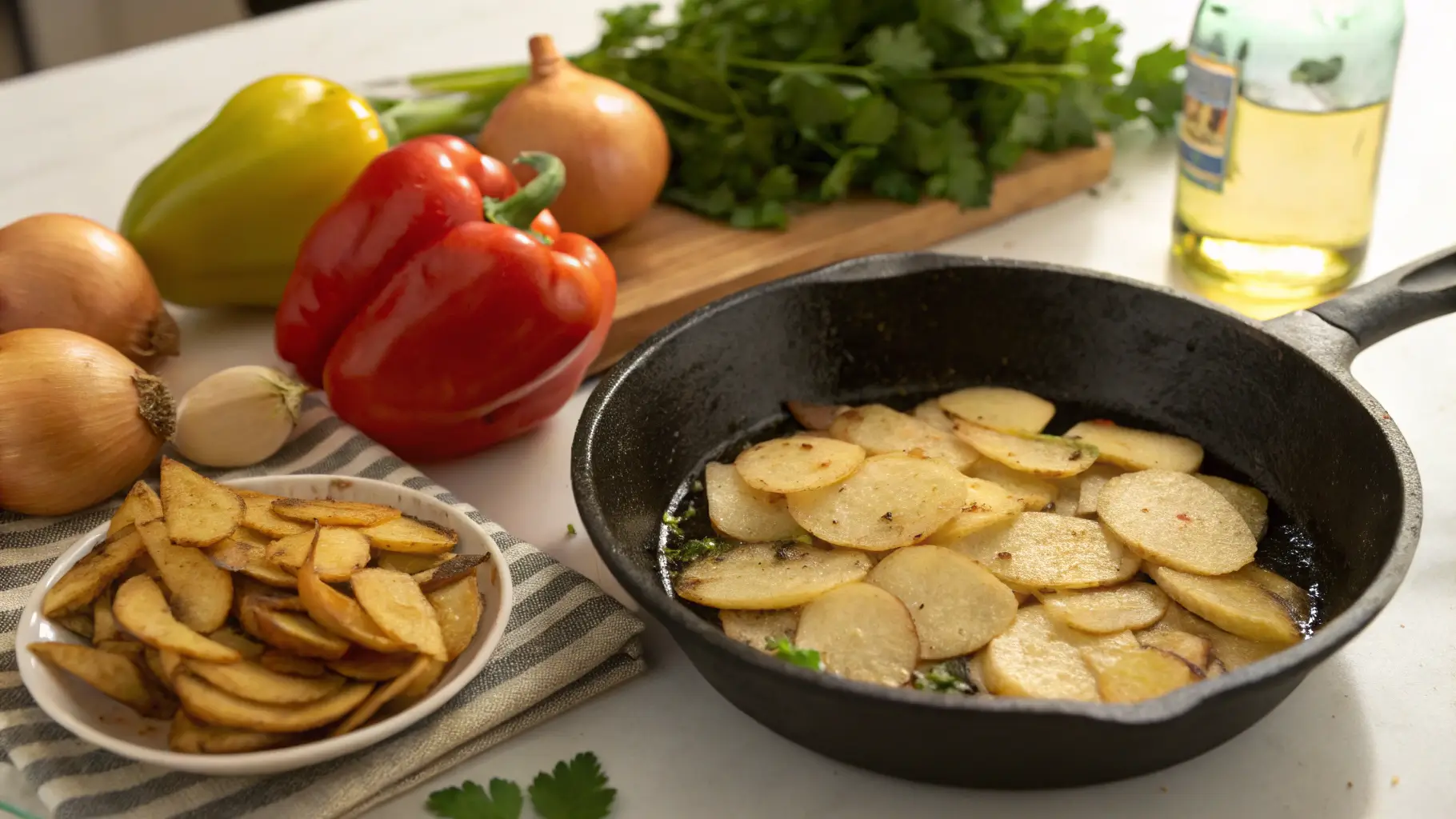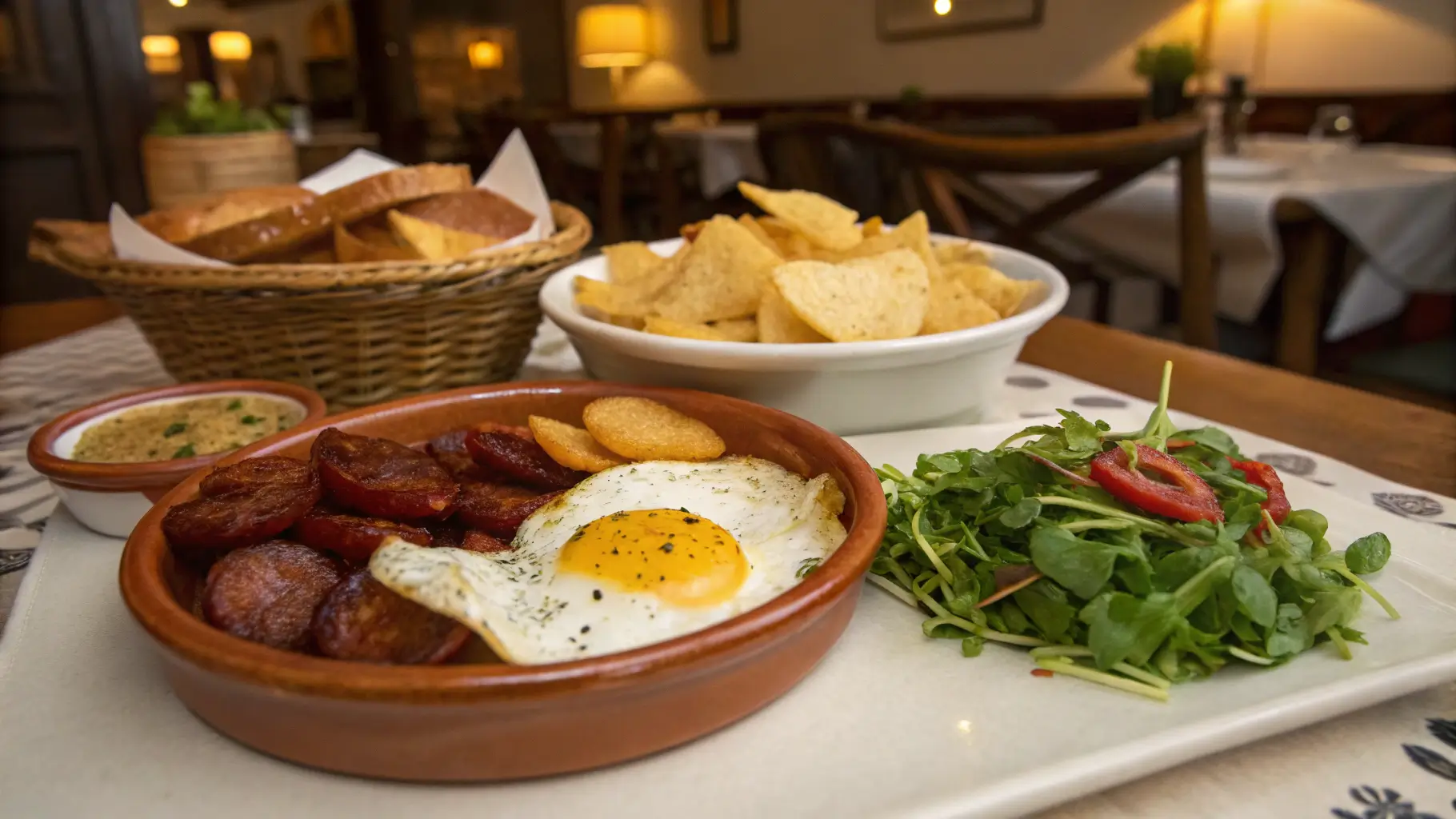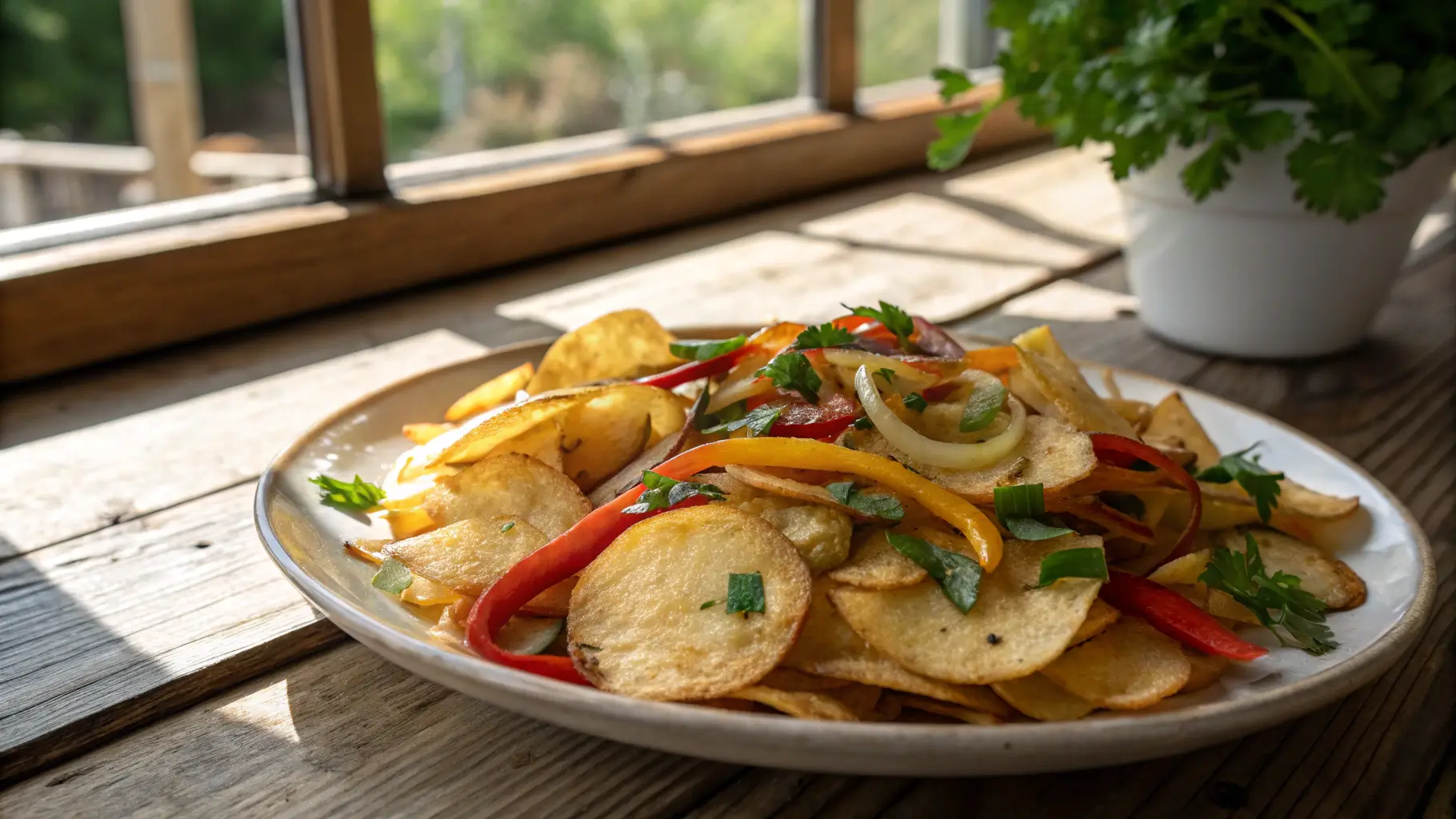Welcome to the world of papas chips pobres, a simple yet heartwarming dish with a story as rich as its flavors. Often called “poor man’s potatoes,” this Spanish classic takes humble ingredients—like potatoes, olive oil, and peppers—and transforms them into a meal filled with charm and nostalgia.
In this article, you’ll learn everything there is to know about this iconic dish. From its origins and preparation to its cultural significance, we’ll walk you through every savory detail. Whether you’re a seasoned chef or a curious foodie, this is your chance to embrace the flavors of simplicity. Let’s dig in!
Table of contents
What Are Papas Chips Pobres?
Origins and Name Meaning
Papas chips pobres translates to “poor man’s potatoes” in English, and the name speaks volumes about its roots. This dish hails from Spain, where it emerged as an affordable way to feed families during tough times. Despite its humble beginnings, papas chips pobres has become a beloved staple on Spanish dinner tables, cherished for its comforting flavors and hearty nature.
In rural Spain, this dish symbolized resourcefulness, turning basic pantry items into something truly satisfying. Over time, it gained popularity not just as a necessity but as a delicious tradition.
The Basic Ingredients
The magic of papas chips pobres lies in its simplicity. Here’s what you’ll need:
- Potatoes: The star of the show, ideally starchy varieties like Russets or Yukon Golds.
- Olive oil: Rich and fragrant, a key to authentic Spanish flavor.
- Peppers and onions: These add sweetness and depth, balancing the potatoes’ earthiness.
- Salt and seasonings: A sprinkle of salt enhances everything, and optional herbs like parsley or thyme elevate the taste.
These ingredients may seem modest, but when combined, they create a dish that’s far greater than the sum of its parts. And that’s the beauty of papas chips pobres—transforming the everyday into something extraordinary.
How to Prepare Papas Chips Pobres

Traditional Cooking Methods
Preparing papas chips pobres is a straightforward yet rewarding process. Begin by peeling and slicing your potatoes into thin rounds—this ensures even cooking. Heat a generous amount of olive oil in a large pan over medium heat, making sure the oil covers the bottom completely.
Add the potatoes to the pan, along with thinly sliced onions and colorful bell peppers. Stir occasionally to prevent sticking, and cook until the potatoes are golden and tender. Season with a pinch of salt, and you’ve got a dish that’s simple but bursting with flavor.
If you’re aiming for an extra crispy texture, try frying the potatoes in batches. This allows each slice to develop that perfect golden edge, elevating the dish’s appeal. The balance of crispy and tender textures is what makes papas chips pobres so delightful.
Popular Variations
Although the traditional recipe sticks to the basics, many home cooks add their own twist to papas chips pobres.
- Eggs: Crack an egg on top during the last few minutes of cooking for a hearty addition.
- Meat: Chorizo or ham brings a smoky, savory element to the dish.
- Herbs: Fresh parsley or thyme adds a touch of brightness.
- Cheese: A sprinkle of Manchego cheese melts beautifully over the hot potatoes.
These variations prove that papas chips pobres can be as versatile as your imagination allows. Whether served as a side dish or the main course, this classic recipe is sure to please.
For a low-carb alternative, you might explore how other ingredients like zucchini or sweet potatoes work as substitutes. (For more on lighter meals, check out this guide to healthy and delicious recipes.)
Nutritional Value and Health Benefits
Why It’s a Healthy Choice
Papas chips pobres may have humble beginnings, but its nutritional benefits are nothing to scoff at. Potatoes are rich in vitamins C and B6, while olive oil provides heart-healthy fats. The inclusion of vegetables like peppers and onions boosts fiber and antioxidants, making this dish a surprisingly balanced meal.
Thanks to its affordability, this dish is not only easy on your wallet but also provides sustained energy. It’s perfect for active lifestyles or for families looking to prepare nutritious meals on a budget.
Adapting for Modern Diets
For those following specific dietary plans, papas chips pobres can easily be adjusted.
- Vegan: Stick to the traditional recipe without adding meat or dairy.
- Gluten-Free: Naturally gluten-free, this dish is safe for those with sensitivities.
- Lower Calorie: Reduce the olive oil or bake the potatoes instead of frying for a lighter version.
- Keto-Friendly: Substitute potatoes with turnips or cauliflower slices to make it low-carb.
By tailoring the recipe, you can keep enjoying papas chips pobres no matter your dietary needs. Plus, its wholesome ingredients make it a dish you can feel good about sharing with loved ones.
Cultural Significance of Papas Chips Pobres
A Dish of Humble Beginnings
Papas chips pobres is more than just food—it’s a reflection of Spanish resilience and ingenuity. Historically, this dish originated during times of economic hardship when families relied on inexpensive ingredients to feed everyone. Potatoes, readily available and filling, became the cornerstone of a recipe that was both practical and satisfying.
In Andalusia, where this dish is especially popular, papas chips pobres represents a deep connection to local agriculture. The use of olive oil highlights Spain’s rich olive-producing regions, while fresh peppers and onions mirror the Mediterranean’s vibrant flavors. Over time, this humble dish gained a special place in Spanish culture, symbolizing the beauty of simplicity.
How It’s Celebrated Today
Today, papas chips pobres is no longer limited to rural kitchens. It has become a beloved part of Spanish cuisine, appearing on tapas menus, in family gatherings, and even at gourmet restaurants. During festivals, this dish often takes center stage, shared among neighbors and friends as a symbol of community.
Its versatility and nostalgic value have made it a favorite not just in Spain but worldwide. Even foodies experimenting with global cuisines love adding their own twist to this classic. This enduring popularity shows that great food doesn’t have to be complicated—it just needs heart.
For more on simple and delicious recipes that carry tradition, consider browsing related guides like this one on unique comfort foods.
Serving Suggestions and Pairings

Perfect Accompaniments
The beauty of papas chips pobres is its ability to pair with nearly anything. Here are some popular accompaniments:
- Grilled meats: Add smoky flavors by serving alongside chicken or lamb.
- Eggs: A fried egg on top turns it into a hearty breakfast or brunch.
- Salads: A simple green salad complements the dish’s richness.
- Dips: Pair with aioli or garlic yogurt for a creamy contrast.
No matter what you serve it with, the dish’s rustic charm shines through.
Regional Twists in Serving
In different regions of Spain, papas chips pobres is served in unique ways. Some areas add local spices, while others incorporate seafood to reflect coastal influences. These regional adaptations highlight the versatility of this dish.
For a contemporary twist, consider using flavored olive oils or garnishing with fresh herbs like cilantro. You might also serve it as part of a tapas spread, alongside olives, manchego cheese, and crusty bread.
When you share this dish with loved ones, it becomes more than just a meal—it’s an experience filled with tradition, creativity, and warmth.
Recipes Inspired by Papas Chips Pobres
Fusion Dishes
Papas chips pobres has inspired countless creative recipes that blend its rustic charm with global flavors. For a unique twist, try making papas chips poblanos, a variation with a spicy kick. Adding roasted poblano peppers and a dash of smoked paprika brings a bold, smoky flavor to the dish.
Another option is to combine papas chips pobres with Italian elements. Picture a plate of crispy potatoes topped with a rich marinara sauce, melted mozzarella, and fresh basil—essentially a potato-based pizza. For fans of Asian flavors, tossing the potatoes with soy sauce, sesame oil, and green onions gives this Spanish classic an exciting makeover.
Fusion dishes like these show how versatile papas chips pobres can be, making it the perfect base for experimenting with international cuisines.
Creative Uses for Leftovers
Leftovers of papas chips pobres are like a blank canvas for more delicious meals. Here are some simple ideas:
- Breakfast Hash: Sauté leftovers with scrambled eggs, spinach, and chorizo for a hearty start to your day.
- Soup Topping: Add crispy bits of leftover potatoes to soups or stews for extra texture.
- Potato Salad: Toss cold papas chips pobres with mayo, mustard, and diced pickles for a quick side dish.
- Casserole Base: Layer the potatoes with shredded cheese, cooked vegetables, and cream, then bake until bubbly.
These ideas turn yesterday’s meal into today’s exciting creation, helping you reduce waste while enjoying something new.
For more recipe inspirations that elevate humble ingredients into culinary delights, explore guides on creative comfort foods or global flavors
Common Mistakes When Cooking Papas Chips Pobres
Avoiding Soggy Potatoes
One common mistake when preparing papas chips pobres is ending up with soggy, oil-laden potatoes. To ensure your dish is perfectly crispy, always dry the potato slices thoroughly after washing. Excess water can interfere with the frying process, causing the potatoes to steam rather than crisp up.
Another helpful tip is to avoid overcrowding the pan. When too many potato slices are fried at once, the oil’s temperature drops, leading to uneven cooking. Instead, fry in smaller batches, allowing each slice to cook evenly and achieve a golden-brown color.
Balancing Flavors
Seasoning is crucial when making papas chips pobres. Adding too little salt can make the dish bland, while over-salting can overwhelm its simple yet delicious flavors. It’s best to season gradually, tasting as you go to achieve the perfect balance.
For those who enjoy experimenting, you can enhance the flavors with a touch of smoked paprika or fresh herbs like rosemary. Using fresh, high-quality ingredients—such as extra-virgin olive oil—will also elevate the dish’s overall taste.
By avoiding these common errors, you’ll create a plate of papas chips pobres that’s crispy, flavorful, and satisfying. Up next, we’ll answer some frequently asked questions to make sure you’re fully equipped to master this classic recipe.
Frequently Asked Questions (FAQs)
Is Papas Chips Pobres the Same as French Fries?
Not exactly! While both dishes involve frying potatoes, papas chips pobres is distinct. It’s cooked with olive oil and often includes onions, peppers, and seasonings, giving it a unique Mediterranean flavor. Unlike French fries, which are crispy throughout, this dish balances tender and crispy textures.
What Potatoes Work Best?
The best potatoes for papas chips pobres are starchy varieties like Russets or Yukon Golds. These types fry well, resulting in a satisfying golden crust. If you prefer a softer texture, waxy potatoes like red or new potatoes also work but may not crisp up as much.
Can It Be Made Ahead of Time?
Yes! It can be made ahead and reheated. To maintain their crispiness, warm them in the oven rather than the microwave. This technique brings back their texture while preserving the dish’s original flavors.
Are There Gluten-Free Variations?
Absolutely! The traditional recipe is naturally gluten-free since it uses potatoes, olive oil, and vegetables. Just ensure any additional seasonings or ingredients, like chorizo, are also gluten-free to keep the dish safe for those with dietary restrictions.
Now that you’ve learned all about the ins and outs of papas chips pobres, why not try making it yourself? Stay tuned for the conclusion, where we’ll sum up the key takeaways and encourage you to embrace this humble yet delicious dish.
Conclusion and Final Thoughts
Papas chips pobres is much more than a simple dish—it’s a celebration of resourcefulness, tradition, and heartwarming flavors. This Spanish classic shows us how basic ingredients like potatoes, olive oil, and peppers can create something extraordinary when prepared with care and love.
From its humble beginnings in rural Spain to its modern adaptations in kitchens worldwide, papas chips pobres has proven its timeless appeal. Whether you’re serving it as a comforting family meal, a creative fusion dish, or part of a festive tapas spread, this recipe brings people together with its unpretentious charm.
Now that you know the origins, preparation, and ways to enjoy this iconic dish, it’s time to roll up your sleeves and give it a try. Remember, great food doesn’t have to be complicated—it just needs a pinch of passion. Enjoy every bite of this simple yet unforgettable recipe!






